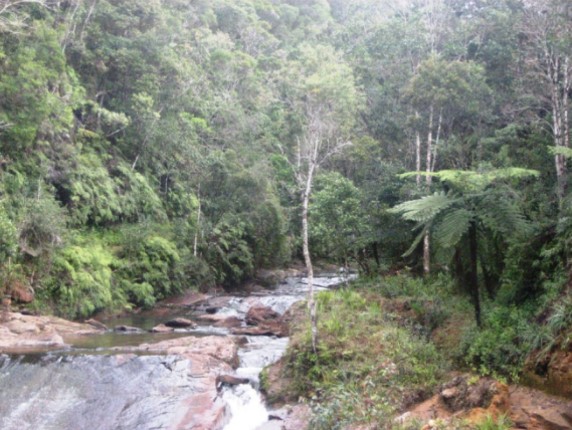
Ben Vorspan completed his four-month internship in Madagascar with "L'Homme et l'Environnement" NGO, working to develop the capacities of partner associations and facilitating workshops, strategic development and monitoring and evaluation.
The descent from Antananarivo to Ambavaniasy is spectacular. As Route National 2 winds slowly from the high plateau to the tropical coast, the phenomenal diversity of Madagascar’s people and landscapes is exposed. The red mountains are dotted with swaths of pine forests; the valleys are terraced with rice-paddies. As the road descends, the crisp mountain air thickens with the aromas of nature. The red earth births temperate forests, an impossible array of flowers, and raging streams. The air is no longer crisp, now sitting heavy amongst the tropical trees. The journey traverses vast mountains, more often than not on dilapidated roads, clinging precariously to the sides of cliffs. For this Glocal intern, the journey was made by taxi-brousse ("bush taxi" en francais) the local form of "transportation," which has become such a cultural pillar that entire art galleries and restaurants are themed taxi-brousse.
So what exactly is a taxi-brousse? The taxi-brousse is Madagascar’s one and only mode of transportation, plowing the roads of this particularly under-paved island, the world’s fourth largest. Roughly the size of a monit-sherut (a service taxi in Israel), drivers unabashedly employ the ‘more-the-merrier’ business methodology, and fill the poor things to the brim.
Malagasy people tend to be smaller in stature, which only encourages drivers to pile ‘um in. Worry not - taxi-brousses are not discriminatory. These pluralistic, diesel spewing, metal cages hardly limit their load to human cargo (whose seats include, but not limited to, laps); any negative space is tightly packed with baskets, fruits, rice, and of course, no small amount of livestock. Now, I consider myself a taxi-brousse veteran of sorts, having accrued enough taxi-brousse frequent-flyer points to take me to the moon and back, business class. I did, however, adhere to the "NEVER TRAVEL AT NIGHT" rule instilled in me by friends, Malagasy and foreigners alike.
After one particularly exhausting field visit, my boss and I decided to head home to Antananarivo early. The only problem was -- it was getting late. We calculated that we could arrive in Moramanga by dusk, from where we could take a 2.5 hour taxi-brousse journey back to Antananarivo, putting us in at around 20:30. Reasoning that bandits and armed highway robbers probably need a good dinner before a night's work of stopping taxi-brousses at gunpoint, we decided to head home. We'd have a hot shower by 21:00. So off we went. Half-way through the journey, my boss asked, "Is the driver slowing down?" "I don’t know," I replied absent-mindedly. “But it sure is dark.” And then it dawned on us, or rather, “dusked” on us. The headlights had gone off, as had the rest of the taxi-brousse's electrical system. We were now being guided by the cellphone lights of passengers hanging their hands out the windows.
It was pitch black, and the deep valleys beneath us were no more distinguishable than the road in front of us. So, we pulled over. "No hot shower tonight," I mumbled to my boss, as we all shuffled out of the car, wary not to lose footing and suddenly plummet to the rice-paddies hundreds of meters below. As I began to ponder how I would locate my sleeping bag, everyone piled back into the car. To my dismay, the driver was going to attempt to continue. He pulled into the middle of the road, but couldn't see the road ahead of us, so he decided to wait it out. “At least the bandits can't see us,” I joked. “And neither can the approaching camion,” my boss replied. "C'est quoi un camion (what is a Camion)?" I asked, deciding to utilize this time to practice my French. But she didn't need to respond. The headlights were approaching fast, and we were pitch-black and silent. Rounding the bends at harrowing speeds, the camion (tractor-trailer truck) was probably not in the condition to break.
So I closed my eyes, waited for impact, and considered releasing the contents of my bladder. 'Hooooonnnnnkkkkkkkkkk" Narrow miss.
But, our driver, unphased by the open doors of our taxi brousse, saw his moment. Having narrowly escaped a head-on collision with a semi-truck that would have undoubtedly sent us careening to our “rice-y” deaths, the driver adopted the “make-friends-with-your-enemies” philosophy and took off after the semi-truck. Hurling around curves and diving into potholes, the driver maintained a “safe” distance of about 1.5 meters from our new source of light, an 18-wheeled camion, oblivious to our presence. You get the picture.
Six-harrowing hours later, we arrived in Antananarivo. As I moved through the city’s streets at midnight, I counted my lucky stars, only on this particularly dark night, they were behind clouds. I got home and hopped in the shower. It was cold. Moral of the story, when you work in development, there is more to life than hot showers.
Ben Vorspan


